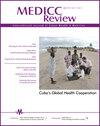改善非洲易患酮症的2型糖尿病的诊断。
IF 1.8
4区 医学
Q3 PUBLIC, ENVIRONMENTAL & OCCUPATIONAL HEALTH
引用次数: 1
摘要
本文章由计算机程序翻译,如有差异,请以英文原文为准。
Improving Ketosis-Prone Type 2 Diabetes Diagnosis in Africa.
Diabetes mellitus (DM) is a serious health problem with high— and increasing—prevalence and incidence around the world. Africa, with a considerable communicable disease burden, is not exempt and is facing greater DM risk due to rapid demographic, sociocultural, economic and nutritional changes. According to the International Diabetes Federation, Africa will experience the largest jump in DM prevalence (143%) of all regions over the next 25 years.[1,2]
求助全文
通过发布文献求助,成功后即可免费获取论文全文。
去求助
来源期刊

Medicc Review
PUBLIC, ENVIRONMENTAL & OCCUPATIONAL HEALTH-
CiteScore
3.30
自引率
9.50%
发文量
49
审稿时长
>12 weeks
期刊介绍:
Uphold the highest standards of ethics and excellence, publishing open-access articles in English relevant to global health equity that offer the best of medical, population health and social sciences research and perspectives by Cuban and other developing-country professionals.
 求助内容:
求助内容: 应助结果提醒方式:
应助结果提醒方式:


